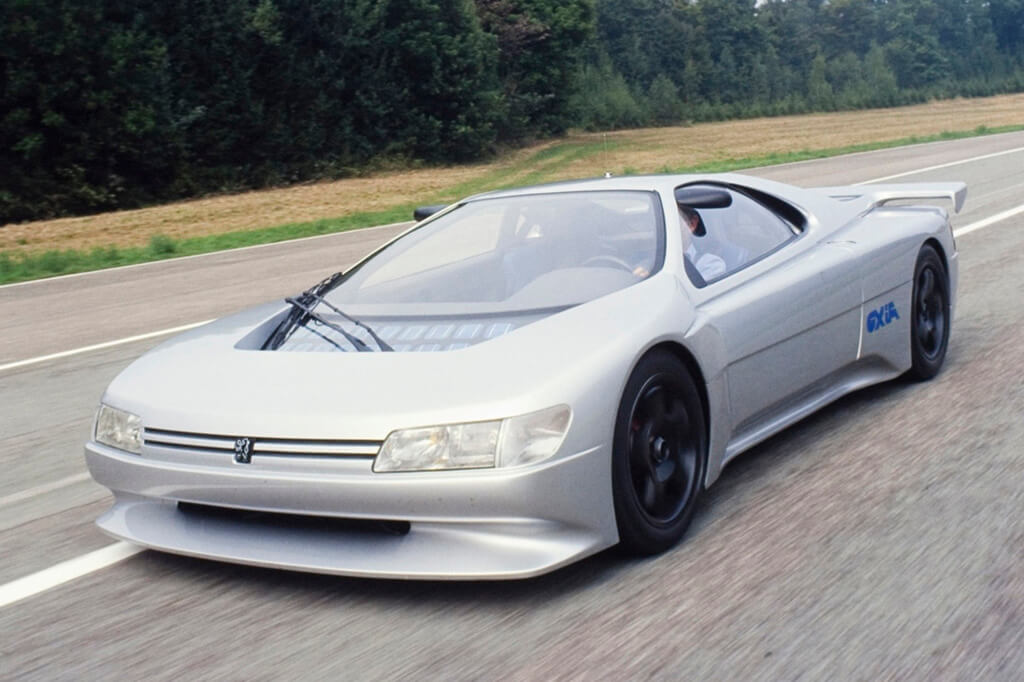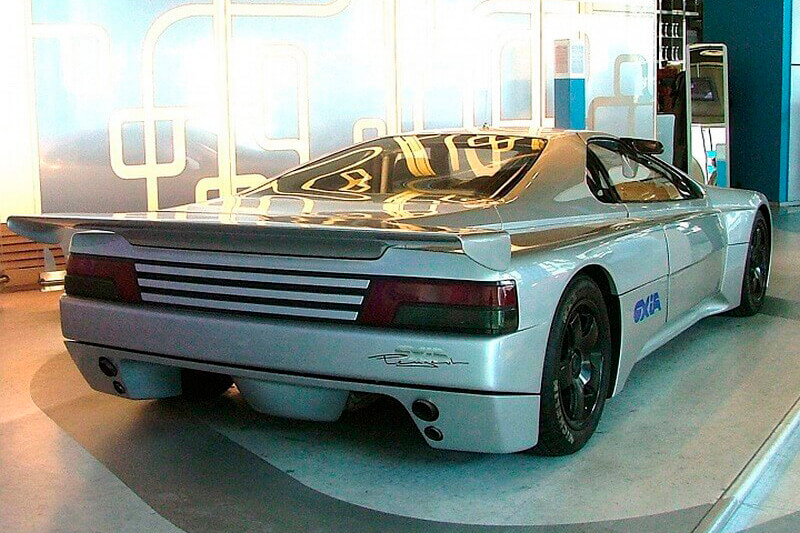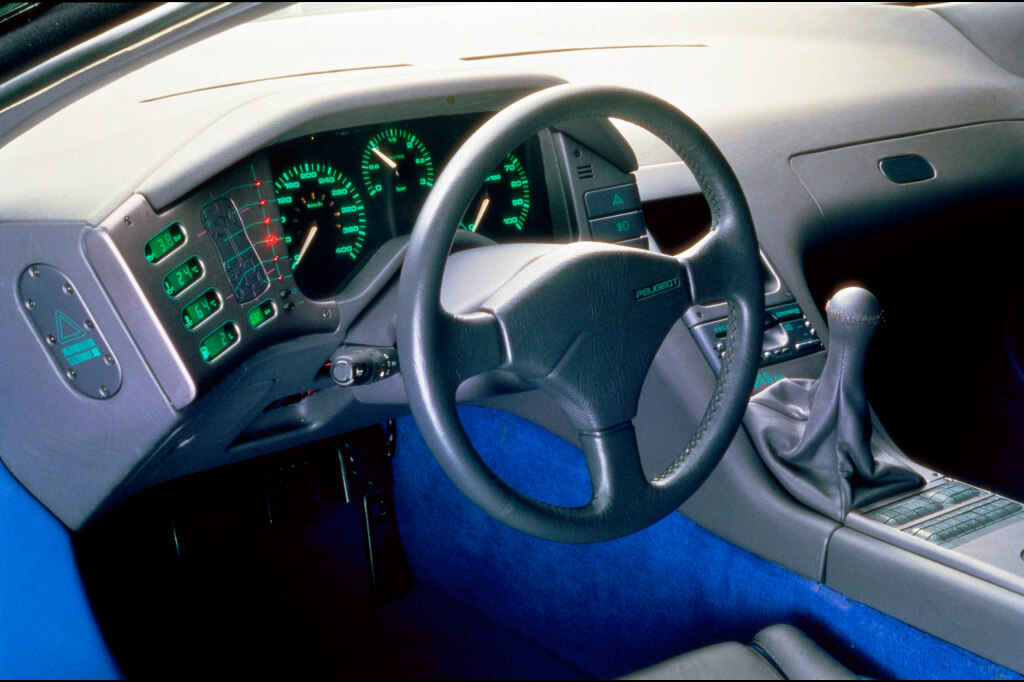Peugeot Oxia Concept
Description
The Peugeot Oxia Concept, a prototype presented at the 1988 Paris Motor Show, was developed at the La Garenne research center. The name comes from the region of Mars "Oxia Palus", where longitude and latitude are 0, a possible starting point for calculating time on Mars.
Immediately after the show, the concept settled for many years in the brand’s signature museum in the town of Sochaux. And at the end of 2009, the only example of the Oxia built was sold for 141,500 euros in private hands at the Musee de l’Aventure estate sale.
Engine
The Peugeot Oxia used a 2.85 L V6 24-valve petrol engine developed jointly by Peugeot, Renault and Volvo (PRV) under the direction of Gerard Walter, who developed the engine for the WM P88 Peugeot of Le Mans. Created on the basis of the “international” block PRV PSA ZN (aka Renault Z7W), with cylinder dimensions of 91.0×73.0 mm, it had a compression ratio increased to 10.0, and two additional Garrett T3 turbochargers with a boost pressure of 1, 22-1.27 bar were equipped with a system that changes the cross-section of the channels, allowing you to increase the speed of gases and regulate the speed of the impeller, ensuring more efficient operation in an extended speed range. In addition, the computer control program provided the possibility of a short-term, up to 45 seconds, “afterburner”, increasing the boost pressure by another 0.1 bar, which made it possible to achieve a maximum torque of 726 N∙m (in normal mode, the maximum torque was equal to only 690 N∙m) in the range from 4500 to 6000 rpm. The engine also had a Bosch Motronic control system, which used two engine control units, one for each cylinder bank.
Transmission
The concept was equipped with a six-speed manual transmission with a double-disc hydraulic clutch and two electronically controlled limited slip differentials, one at the front and one at the rear. The drive was permanent all-wheel drive.
Chassis
The concept's chassis was made of extruded "honeycomb" aluminum, and the body was made of Kevlar and carbon fiber. The entire assembled chassis weighed only 81.6 kg.
On all wheels, a fully controlled circuit was implemented with an electromechanical, on-board computer-controlled (as much as 80 megabytes, twice as much as on the year before last “exhibition” Proxima) all-wheel turning system, which automatically adjusted its operating algorithm in such a way that the angle and direction of rotation of the rear wheels depended on the current speed value, steering angle and tire adhesion parameters to the road surface.
Exterior
A small hood, a wide windshield, no overhangs, and high-mounted electric rear-view mirrors contributed to better aerodynamics and a better view of the road. It also had an adjustable electromechanical rear spoiler controlled by the on-board computer, which changed its angle depending on speed. Deflected by 12 degrees, it made it possible to significantly change the aerodynamic load on the rear axle (because of this, Cx changed only from 0.30 to 0.32, but the downforce doubled). For example, in a raised position configured for better acceleration, at 310 kph the aerodynamic load on the rear axle reached 3500 N, and the total – all 5000.
Interior
The two-seater cockpit, with a steel blue anodized aluminum dash and dark gray leather trim with electric seats, featured a telephone and a now-familiar multimedia system that used the power of a built-in personal computer with a keyboard and trackball instead of a mouse. All information was displayed on a color display, and the map scale in navigation mode automatically changed depending on the speed of the vehicle. The database contained all the information about hotels and vacation spots along the selected route; real-time data on the weather and traffic conditions was also displayed. The Clarion stereo system read CDs, and both doors had built-in individual controls for the driver and passenger.
The Peugeot Oxia also had full automatic climate control, and when parked with the engine turned off, the system maintained the temperature in the cabin thanks to 18 solar photovoltaic modules located under the windshield.
Sources
Specification
| Bodywork | |
|---|---|
| Presentation | |
| Years of production |
1988
|
| Produced (pcs.) |
1
|
| Body type |
купе
|
| Number of doors |
2
|
| Number of places |
2
|
| Engine | |
|---|---|
| Engine type |
бензиновый
|
| Engine location |
центральное, поперечное
|
| Engine model |
PRV (PSA ZN/Renault Z7W)
|
| Cylinders |
V6
|
| V-angle |
90°
|
| Cylinder operation |
1-6-3-5-2-4
|
| Capacity (cc) |
2849
|
| Power output (hp / kW /) |
680 /
500 /
|
| at rpm |
8200
|
| Torque (N·m) |
726
|
| at rpm |
4500
|
| Bore (mm) |
91,0
|
| Stroke (mm) |
73,0
|
| Compression |
10,0
|
| Number of valves |
4/24
|
| Valvetrain |
SOHC
|
| Block material |
алюминиевый сплав
|
| Engine weight (kg) |
150
|
| Fuel system |
впрыск
|
| Fuel system model |
Bosch Motronic
|
| Turbocharger |
2
|
| Compressor model |
Garret T3
|
| Turbo pressure (bar) |
1,22-1,27
|
| Specific | |
|---|---|
| Specific output (hp/litre) |
238,68
|
| Specific output (hp/tonne) |
494,91
|
| Specific output (kg/hp) |
2,02
|
| Specific torque (N·m/litre) |
254,83
|
| Specific torque (N·m/tonne) |
528,38
|
| Transmission | |
|---|---|
| Driven wheels |
полный
|
| Clutch |
двухдисковое
|
| Gearbox model |
PSA TJ
|
| Gearbox |
механическая
|
| Number of speeds |
5
|
| Final drive ratio |
4,396
|
| First gear ratio |
2,923
|
| Second gear ratio |
1,944
|
| Third gear ratio |
1,322
|
| Fourth gear ratio |
0,967
|
| Fifth gear ratio |
0,757
|
| Reverse gear ratio |
3,154
|
| Suspension | |
|---|---|
| Front suspension |
независимая на двойных поперечных рычагах
|
| Rear suspension |
независимая на двойных поперечных рычагах
|
| Elastic elements in front |
пружины
|
| Elastic elements in rear |
пружины
|
| Front anti-roll bar | |
| Rear anti-roll bar | |
| Tire brand |
Michelin
|
| Tyres front |
235/45 R17
|
| Tyres rear |
285/40 R17
|
| Steering | |
|---|---|
| Steering type |
шестерня-рейка
|
| Power steering |
гидравлический
|
| Brakes specs | |
|---|---|
| Brakes front |
дисковые вентилируемые
|
| Brakes rear |
дисковые вентилируемые
|
| Anti-lock braking system |
да
|
| Dimensions and weight | |
|---|---|
| Body material |
углеволокно, кевлар
|
| Length (mm) |
4610
|
| Width (mm) |
2020
|
| Height (mm) |
1130
|
| Wheelbase (mm) |
2800
|
| Front track (mm) |
1735
|
| Rear track (mm) |
1684
|
| Ground clearance (mm) |
120
|
| Drag coefficien |
0,300
|
| Dry weight (kg) |
1250
|
| Curb weight (kg) |
1374
|
| Performance specs | |
|---|---|
| Fuel type |
бензин
|
| Dynamic specs | |
|---|---|
| Acceleration 0-100 kph (s) |
3,6
|
| Top speed (kph) |
349
|
|---|---|
| Top speed (mph) |
217
|



